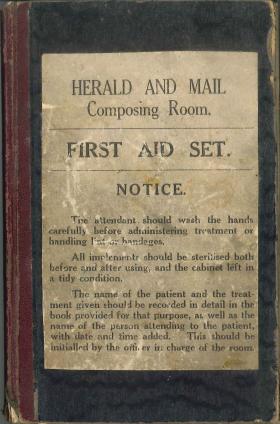The Herald and Mail Composing Room First Aid Diary

This First Aid diary kept by the composing room of the Herald and Mail newspaper provides a fascinating look into the dangers of working in the printing industry from the 1930s to 1960s. The diary details not only what was kept in the first aid cabinet but also records the injuries received and treatment given. The diary contained three sheets of paper with the following narrative about the diary.
In Hunter Street the Herald's composing room maintained a first aid set, particularly to deal with people on night staff who suffered minor injuries. Several members of composing room simultaneously held first aid certificates. The aim seemed to be to treat injuries which did not justify sending the patients to hospital casualty. Presumably, some people who suffered very minor hurts were able to continue working. Others were made comfortable and sent home with advice about seeing a doctor after a sleep. The attached booklet lists cases handled between September 1933 and May 1966. Presumably this first aid system faded out as the night service in the Medical Centre developed. The records show that in the 20 years from 1933 to 1953 the composing room first aid men handled about 350 patients: (250, cuts, wounds, scratches - 41 burns - 57 bruises 12 splinters - 11 falls). Less than a dozen were sent to hospital immediately after first aid treatment.
Of course, there may have been an odd serious injury case not listed here because the first aid men felt it necessary to call an ambulance urgently. But the first aid men didn't dodge some awkward jobs. For instance. First entry in the book records that one Higgs suffered severe metal burns on one hand and slight burns on scalp. Treatment was: "Picric acid on hand and head and hair cut to remove metal". Today, you would need more than a first aid badge if you wanted to chop into a man’s hair
Among about 20 items listed for the complete first aid chest was a bottle of brandy. Throughout the book replacements are listed for bandages antiseptic etc. but there is nothing to show whether the 1933 bottle of brandy was ever emptied
The entries made by the first aid attendants indicate that in the largest group of cases (cuts, wounds and scratches), injuries to hands or fingers predominated. Many of these injuries needed only antiseptic and sticking plaster. These injuries were sustained on a wide variety of machinery, including galley presses and saws.
A surprising number of minor cuts were attributed to column rules. In the burns classification most of the injuries were caused by hot stereo or lino metal. There were a few due to scalds, even one attributed to hot tea. Although most of the patients came from typesetting or stereotyping areas there were occasional calls for treatment from messengers, proof readers, advertising, cleaners, artists, photographers and engineers.
Author
Peter Arfanis, Project Lead, State Library of New South Wales, 2017
Series 080: Diary of the Herald and Mail composing room first aid box, 1933-1966. MLMSS 9894/Box 127